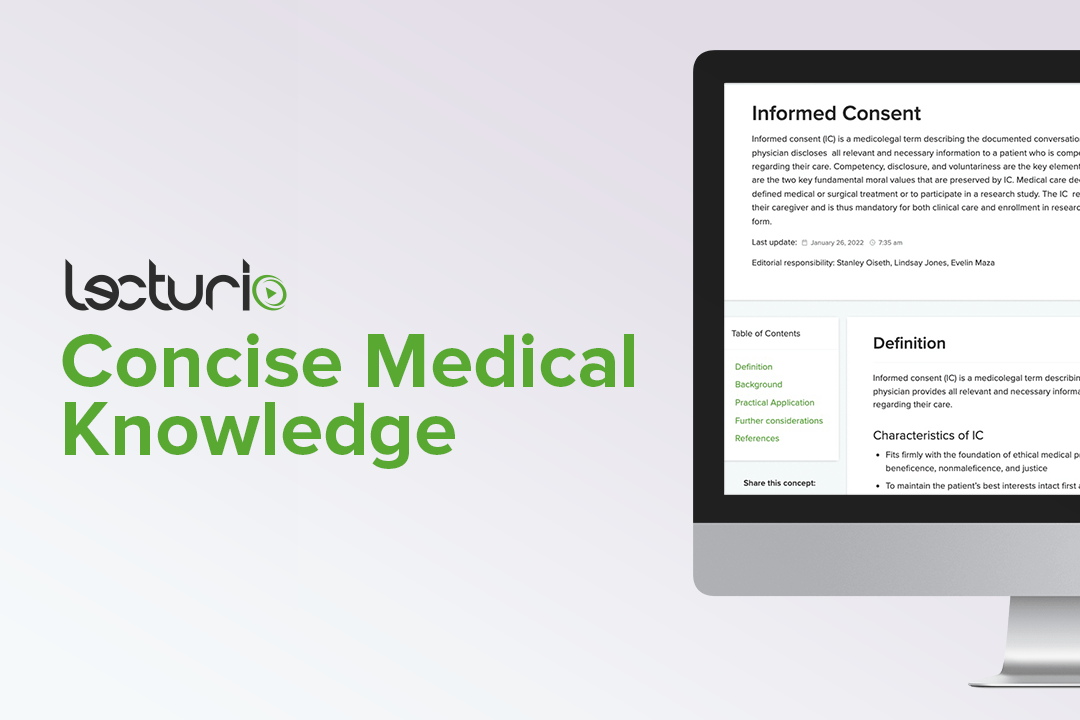Playlist
Show Playlist
Hide Playlist
Strategies to Aid Understanding
-
Slides Introduction to Informed Consent.pdf
-
Reference List Clinical Ethics.pdf
-
Download Lecture Overview
00:01 All right. So I think in understanding, after we've disclosed the information, really important to make sure that we assess comprehension. 00:10 And the ways that you're going to disclose the information is going to influence the patient's ability to understand it. 00:16 So hopefully, you would go through this slowly and clearly. 00:20 You shouldn't just sort of rush through, risk benefits alternatives, very quickly. 00:25 You need to give enough time so the patient can hear the information and process it. 00:31 It's best if you use non-medical language, so don't use the medical terminology. 00:35 If you do use it, then try to define the term. 00:39 If the patient has used their own terms to describe their condition, good to use those who because that's going to reinforce the patient's understanding. 00:48 Always helpful to use analogies. 00:50 So wherever you can sort of paint a picture for a patient through the use of analogies that might help to aid their understanding. 00:58 And even just, actually drawing pictures. 01:00 So if it's a surgery and you're proposing surgery on their liver, describing or actually drawing a picture of the anatomy of the abdomen, and where the liver is and what you're intending to do. 01:16 And I'll be helpful for the patient understand what the surgery is going to entail. 01:22 And a lot of people might have difficulty with numeracy or not understanding numbers. 01:28 So it's best not to use probabilities and percentages, but try to use numbers clearly. 01:34 So say, one out of 10 rather than 10%, for instance, make it understandable so that the patient could comprehend it, and then have that as useful information. 01:47 And I think a very useful strategy is something called Ask-Tell-Ask. 01:50 So you first ask a question. 01:53 Try to explore what the patient already knows. 01:56 Then you tell some information. 01:59 And then you ask about the information that you've shared. 02:02 So it's a back and forth. 02:03 And as you see, it's Ask-Tell-Ask which means more weight is placed on the patient talking rather than the clinician talking. 02:11 So in the in the old days, the informed consent used to be just the disclosure of information, sort of a soliloquy by the physician. 02:19 But in this case, with Ask-Tell-Ask, you're really trying to engage the patient in talking as you're disclosing the information. 02:28 So how would it work? So the first ask would be, what do you know about your condition, or this proposed treatment? Maybe they've had prior experience with maybe they've had a family member that's gone through a similar thing. 02:40 So they might already have some background knowledge, and that's going to lead again in their understanding. 02:47 If they're unaware of something, then you give them a certain amount of information, a chunk of information. 02:52 It shouldn't be a long list of things. 02:54 It should hopefully just be in chunks, so short segments that they can then process. 03:00 And then you follow that up with an ask question. 03:02 "So what do you think about what I've said? Or can you tell me in your own words, what I've said?" That's a way that you're going to make sure that they are processing it, and using their own own words or own language to describe it. 03:18 And it's important to recognize that this is an iterative process. 03:21 So it's a ongoing back and forth. 03:23 So you explain the concept. 03:25 You assess their comprehension. 03:28 If they don't get it quite right, then you might clarify the details, then you reassess their comprehension. 03:33 So you're continually trying to reinforce their understanding. 03:38 And it's also going to be helpful in terms of adherence to treatment in the future. 03:41 So if it is prescribing a medication, the better they understand it up front, and what's required, the more likely they are to adhere. 03:48 Or if it's a surgery, or procedure, what do they need to prepare for what they need to go through after the procedure or surgery, all that's an iterative process to get them to an understanding. 04:02 And just recognize that every contact we have with the patient, is an opportunity to reiterate information, reinforce information, to really make sure that their decisions are informed and voluntary.
About the Lecture
The lecture Strategies to Aid Understanding by Mark Hughes, MD, MA is from the course Informed Consent and Capacity.
Included Quiz Questions
Which of the following is a strategy to aid in patient comprehension of information during the informed consent process?
- Drawing pictures
- Using official medical language
- Creating a forest plot
- Showing a PowerPoint presentation
- Using percentages
What is one benefit of "Ask-Tell-Ask"?
- It allows patients to engage in the conversation.
- It provides physicians with an easy way to end a conversation.
- It allows for shorter appointment times and fewer delays in the clinic.
- It provides a way for medical students to become involved in the consent process.
Customer reviews
5,0 of 5 stars
| 5 Stars |
|
5 |
| 4 Stars |
|
0 |
| 3 Stars |
|
0 |
| 2 Stars |
|
0 |
| 1 Star |
|
0 |




